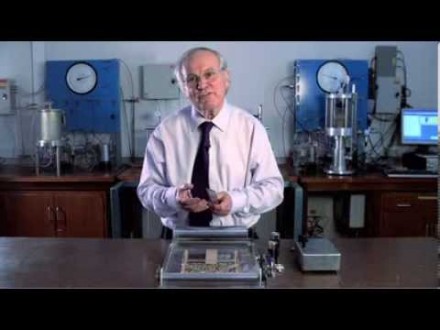In the fifth video in the Bare Essentials of Soil Mechanics series, Professor John Burland explains how important water pressure in the voids between soil particles is in determining the soil’s strength. John describes how major disasters can take place if geotechnical engineers don’t take into account water pressure in soils. More engineering teaching resources available on http://expeditionworshed.org
To reinforce the importance of taking water pressure into account, Professor Burland cites the Aberfan disaster in which an unstable manmade soil mound above the village of Aberfan engulfed a school, killing 116 children and 28 adults.
In the first of two demonstrations, Professor Burland shows how important water pressure is at the contact point between two soil particles. The conclusion is that water pressure reduces the shearing force between particles, reducing overall soil strength.
In the second demonstration, Professor Burland uses the example of building sandcastles at the beach to show how a small amount of water can increase soil strength. He explains this phenomenon by introducing the concept of surface tension.
Learning outcomes
This video will help learners answer questions such as:
- Does soil contain air?
- Does soil contain water?
- Does water make soil stronger or weaker?
- How does pore water pressure affect soil strength?
- How do I build the strongest sand castle?
- What is surface tension?
About the Bare Essentials of Soil Mechanics series
This video is part of the Bare Essentials of Soil Mechanics series, funded by the Ove Arup Foundation, in which Professor John Burland draws on his many years of practice in geotechnical engineering and teaching to provide listeners with what he regards to be the key knowledge that geotechnical engineers need to understand about soil mechanics in engineering practice.
Credits
- Written and presented by: Prof John Burland, Imperial College, London
- Concept design: Think Up
- Graphic design: Thomas Matthews
- Direction/Production: Aeries Films
- Image credits: coming soon
<a rel=”license” href=”http://creativecommons.org/licenses/by/3.0/deed.en_US”><img alt=”Creative Commons License” style=”border-width:0″ src=”http://i.creativecommons.org/l/by/3.0/88×31.png” /></a><br /><span xmlns:dct=”http://purl.org/dc/terms/” href=”http://purl.org/dc/dcmitype/MovingImage” property=”dct:title” rel=”dct:type”>Bare Essentials – Introduction to Geotechnical Engineering</span> by <a xmlns:cc=”http://creativecommons.org/ns#” href=”www.thinkup.org” property=”cc:attributionName” rel=”cc:attributionURL”>Think Up</a> is licensed under a <a rel=”license” href=”http://creativecommons.org/licenses/by/3.0/deed.en_US”>Creative Commons Attribution 3.0 Unported License</a>.<br />Permissions beyond the scope of this license may be available at <a xmlns:cc=”http://creativecommons.org/ns#” href=”info@thinkup.org” rel=”cc:morePermissions”>info@thinkup.org</a>




